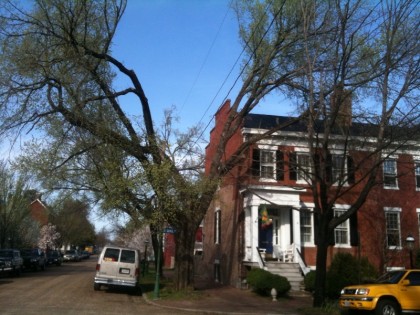RECENT COMMENTS
Joel Cabot on Power Outage on the Hill
Eric S. Huffstutler on What is up with the Church Hill Post Office?
Eric S. Huffstutler on What is up with the Church Hill Post Office?
Yvette Cannon on What is up with the Church Hill Post Office?
crd on Power Outage on the Hill







They came by and cut the ones around us right before that run of snowstorms we had. It was nice not to lose power for a change.
Horrible Butchery. In my opinion it is a brutal insensitive way to treat our city environment. NO other city I have every been to does this to the urban environment.
Yesterday (and more today) I saw them doing an absolutely criminal massacre job on the trees on 29th St. Some of them were left with hardly any branches by the time they were finished. What an outrage. They go WAY beyond what is required to protect the power lines.
I have to agree with #2 and #3. I was driving down 23rd yesterday afternoon and thought how pathetic the trees looked all chopped up like they are. Not that the city cares at all. If they cared, they would hire someone who knows what they are doing to do it in a manner more atheistic. It would add value to the neighborhood rather than adding another eyesore to the area.
Technically it is not the City doing it, it is the power company and phone company. The power company’s right of away agreements allow it broad discretion in clearing limbs.
The politicos around here could dip their toes into the power and phone company waters and make a stink, however. Best option – get the power lines underground and/or in alleys.
#4. An atheistic arborist? BTW, Dominion will put lines underground if the neighborhood agrees to pay for it. Do it in new subdivisions all the time.
#5 & #6, re underground power lines. Yes, they are underground in lots of subdivisions but that’s done at the time of building the subdivision. As I recall from another thread on this blog some time in the past, the cost to do it now would be well into the millions of dollars.
It is sad to see a tree hacked up in this manner. However, the real problem lies with the site selection of tree species when it was planted. Larger tree species should never be planted below power lines. This area should be reserved for smaller ornamental trees. The larger trees can be placed on the opposite side of the street with no overhead obstructions
to provide canopy to the street. This is the result of poor planting decisions from years ago. The tree cutters are really caught between a rock and a hard place.
How can a hack job on a tree as severe as this be 1) healthy for the tree and 2) physically stable (safe)? It looks like a good gust of wind will make the entire tree split down the middle due to weight unbalance.
We have a large old tree on our block and over the years the power company has chosen to save it by insulating the line running through the middle of the tree rather than giving it an “afro-puff” look.
If the only choice was between having power during a winter storm, and having beautiful old trees “wishboned” to the point where they become an eyesore, I might choose the former. But this either/or scenario is a false one. It’s certainly possible to prune a tree with a finer hand than is evidenced in the photo above and maintain adequate space around the power lines. I suspect it’s a matter of expediency that the trees are so drastically cut, and I suppose, ultimately there’s an economic consideration given that a severely pruned tree will require less frequent follow-ups. Still, I have to believe this Draconian cutting will finally result in the premature death of the tree, thus requiring a crew and the attendant expense of removing it. I’m interested in pursuing this matter, as I feel it’s important for preserving the beauty of our neighborhood, and I’m wondering if anyone has any ideas as to how to proceed. I’ve written the city arborist, and am waiting for his reply.
RE: #8 – Exactly. I have always wondered why they plant the big ones underneath the lines instead of the clear side of the street, too. Looks ridiculous.
http://pubs.cas.psu.edu/FreePubs/pdfs/uh180.pdf
74.125.93.132/search?q=cache:XRfa10M3W9…